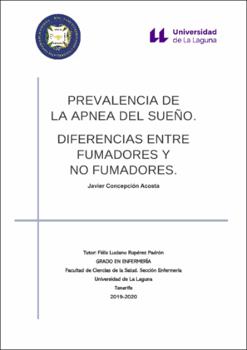Prevalencia de la apnea del sueño. Diferencias entre fumadores y no fumadores.
Fecha
2020Resumen
Introducción: El Síndrome de Apnea-Hipopneas de Sueño (SAHS) es un trastorno que
se produce por la oclusión intermitente y repetitiva de la vía aérea superior que se
desencadena durante el sueño, provocando una interrupción completa (apnea) o parcial
(hipopnea) del flujo aéreo. Constituye la tercera enfermedad respiratoria más frecuente
tras el asma bronquial y el EPOC. Ocurre con mayor frecuencia durante el sueño y
también es la principal causa de hipoxia crónica. Para su diagnóstico se lleva a cabo la
polisomnografía principalmente. Como tratamiento de primera elección encontramos la
CPAP o Presión Continua Positiva en la Vía Aérea además de otras medidas higiénicodietéticas y para el control de enfermedades asociadas.
Objetivos: Comprobar la prevalencia del SAHS en sujetos de 45 a 70 años, en el Área
de Salud de la Zona Norte de la isla de Tenerife, incluyendo a todos los pacientes que
tengan como referencia el Hospital Universitario de Canarias.
Metodología: Se plantea un estudio tipo descriptivo y cuantitativo de corte trasversal en
el que se reflejará la relación entre la prevalencia de la apnea del sueño con factores de
riesgo propios de esta población, diferenciando como varía entre fumadores y no
fumadores. Se seleccionarán a sujetos de entre 45 y 70 años que presenten apnea del
sueño diagnosticada, que residan en algún municipio del norte de la isla de Tenerife y
que mantengan como hospital de referencia el Hospital Universitario de Canarias. Para
ello se llevará a cabo mediante un cuestionario de elaboración propia recopilando así
toda la información necesaria. Introduction: Sleep Apnoea and Hypopnea Syndrome (SAHS) is a disorder that is
produced by intermittent and repetitive occlusion of the upper airway that are triggered
during sleep, causing a complete interruption (apnoea) or partial (hypopnea) of air flow.
It constitutes the third most frequent respiratory disease after bronchial asthma and
COPD (Chronic Obstructive Pulmonary Disease). Occurs more frequently during sleep
and it is also the main cause of chronic hypoxia. For its diagnosis, polysomnography is
done. As treatment of first choice we find CPAP (Continuous Positive Airway Pressure)
and other hygienic-dietary measures and for the control of associated diseases.
Objectives: Check the incidence of SAHS in subjects aged 45 to 70, in the Basic Health
Area of the North Zone of the island of Tenerife, including all patients whose reference
is the University Hospital of the Canary Islands.
Methodology: A descriptive and quantitative cross-sectional study is proposed which
will reflect the relationship between the incidence of sleep apnoea with risk factors typical
of this population differentiating how it varies between smokers and non-smokers.
Subjects between 45 and 70 years with diagnosed sleep apnoea will be selected,
residing in a municipality in the north of the island of Tenerife and that keep the University
Hospital of the Canary Islands as a reference hospital. For this, a questionnaire of own
elaboration will be use compiling all the necessary information.





